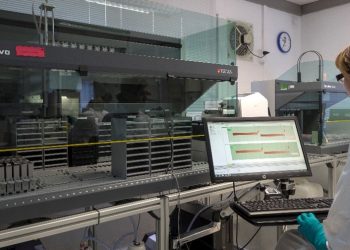Coccidiosis treatment – What you need to know:
The poultry gut is without doubt one of the most complex biological systems and its balance and health become so vulnerable, especially when “pushed to the edge”, as in modern poultry farming. In fact, under these circumstances, there are plenty of factors that can disrupt the perfect balance between nutrients & gut microflora and they are not necessarily pathogen-linked.
 Eimeria spp. show pathognomonic gross lesions that are typical of the parasite and cannot be confused with any other pathogen.
Eimeria spp. show pathognomonic gross lesions that are typical of the parasite and cannot be confused with any other pathogen.
Would it not be better to look for something other than a coccidiosis treatment?
In day-to-day practice, most intestinal problems can be traced back to an underlying coccidiosis that triggers Clostridia overgrowth in the intestine and finally leads to bacterial/necrotic enteritis.
For this reason, a coccidiocidal is very often used for coccidiosis treatment, sometimes accompanied by an antimicrobial, but is this always the correct diagnosis?
It is true that Eimeria is a ubiquitous parasite, but it is also true that coccidiosis gross lesions have (luckily for us) very typical patterns and appearance that cannot be confused with any other pathogen.
In fact, these lesions are so recognisable that in 1970 Johnson & Reid drew a lesion scoring technique that is still valid today and is very widely used for coccidiosis diagnosis .
Having said this, why would we suspect coccidiosis if we do not see these typical lesions?
If we do not see typical lesions, we should not assume that coccidiosis is the first trigger factor or at least it should not be considered as the only one.
This is even truer when the preventive measure used to combat coccidiosis is an attenuated coccidiosis vaccine.
Recently, it was demonstrated that attenuated coccidiosis vaccines are able to prevent necrotic enteritis (Dardi et al., 2019) as in fact they keep coccidiosis under control.
So what should we think when bacterial/necrotic enteritis appears in birds vaccinated with an attenuated coccidiosis vaccine?
In the vast majority of these cases, a treatment with an antimicrobial effective against GRAM+ is enough for the birds to recover, not without consequences for performance, that is clear, but at least to stop mortality.
The fact that an antimicrobial treatment works better than a coccidiosis treatment should not be taken here as a suggestion that it is the treatment of choice, but as a clue that is showing us something else: the primary origin of the gut imbalance and the consequent Clostridia overgrowth has to be investigated for reasons other than coccidiosis, especially when an attenuated coccidiosis vaccine has been used.

In these cases, one of the first causes that has to be investigated is the feed, in terms of quality of raw materials (e.g. presence of mycotoxins), correct balance of nutritional principles and frequency of changes in feed composition.
The latter can lead to continuous changes in the gut microflora provoking disruptions in the gut balance.
On the other hand, we cannot overlook as possible causes pathogens that can cause enteritis directly (Rotavirus, Chicken Astrovirus, Avian nephritis virus 3 and Reovirus) and therefore trigger the overgrowth of Clostridia.
In any case, the ultimate development of bacterial/necrotic enteritis disease is a Clostridia overgrowth which can be kept under control not only with antibiotics, but also with the prophylactic use of feed additives that are able to promote the right balance in the gut microflora (such as probiotics) or organic acids that have a direct antimicrobial effect against Clostridia (such as lauric acid).
Of course, the primary cause will always have to be investigated in order to prevent the disease at its root; however, it is not always possible/easy to find it and to apply corrective measures.
For this reason, we can try to apply the most appropriate treatment by identifying or excluding a possible involvement of coccidiosis as the trigger factor.
REFERENCES:
- Johnson J., Reid W.M., 1970. Anticoccidial drugs: lesion scoring techniques in battery and floor-pen experiments with chickens. Exp. Parasitology 28(1): 30-6.
- Dardi M., Pantoja L. A., van Eerden E., 2019. Efficacy of an attenuated coccidiosis vaccine in combination with different feed additives on production performance and intestinal lesions in broilers challenged with necrotic enteritis. Proceedings of the 21st World Veterinary Poultry Association Congress. Bangkok, Thailand.



